

Managing the value of your talent: a new framework for human capital measurement - Research Reports.
Oubs_perspectives_intercultural_final. Think, Act, Report: Virgin Trains East Coast - Case study. Building on the legacy of East Coast Trains, new owners Virgin Trains East Coast (from March 2015) want to continue to deliver the best customer experience.
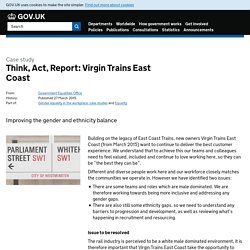
We understand that to achieve this our teams and colleagues need to feel valued, included and continue to love working here, so they can be “the best they can be”. Different and diverse people work here and our workforce closely matches the communities we operate in. However we have identified two issues: There are some teams and roles which are male dominated. We are therefore working towards being more inclusive and addressing any gender gaps.
Issue to be resolved The rail industry is perceived to be a white male dominated environment, it is therefore important that Virgin Trains East Coast take the opportunity to become a more diverse and inclusive organisation to enable us be even more high-performing, profitable and customer focussed. Gender equality in the workplace: case studies. Gender equality in your workplace. Women earn around 18% less on average than men, despite efforts to remove barriers in the workplace.
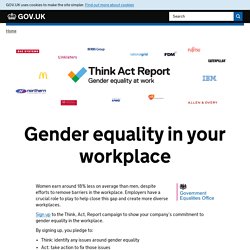
Employers have a crucial role to play to help close this gap and create more diverse workplaces. Sign up to the Think, Act, Report campaign to show your company’s commitment to gender equality in the workplace. By signing up, you pledge to: Think: identify any issues around gender equality Act: take action to fix those issues Report: on how your business ensures gender equality Think, Act, Report is a voluntary initiative to help employers close gender pay gaps. Why sign up? Gender_Salary_Reporting_Guide.pdf. Show-me-the-money_2015-behavioural-science-of-reward.pdf. Over-qualification-and-skills-mismatch-graduate-labour-market.pdf. Are talent programmes ageist? Job design. Videos - MeetTheBoss. Thomson Reuters IDS. Home - Hong Kong Institute of Human Resource Management.
Unit 3 Markets Governments Regulation. Unit 4 Changing Social and Technological Environment. Unit 7 Managing Labour Flow. Agile Future Forum - Supporting UK growth. Untitled. SK0156_Research_Report.pdf. GTP_EA_final_v7_FOR_WEB.pdf. HPW_FOR_WEB.pdf. HR Journals. Employee turnover and retention. This factsheet was last updated in November 2014.
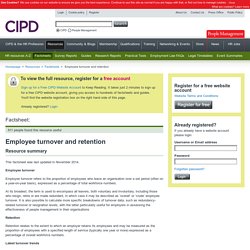
Employee turnover Employee turnover refers to the proportion of employees who leave an organisation over a set period (often on a year-on-year basis), expressed as a percentage of total workforce numbers. At its broadest, the term is used to encompass all leavers, both voluntary and involuntary, including those who resign, retire or are made redundant, in which case it may be described as ‘overall’ or ‘crude’ employee turnover.
It is also possible to calculate more specific breakdowns of turnover data, such as redundancy-related turnover or resignation levels, with the latter particularly useful for employers in assessing the effectiveness of people management in their organisations Retention Retention relates to the extent to which an employer retains its employees and may be measured as the proportion of employees with a specified length of service (typically one year or more) expressed as a percentage of overall workforce numbers. Evaluating learning and development. Center for Evidence-Based Management. 70:20:10 - a model approach for learning?
REX/Isopix Every so often a new “flavour of the month” comes along in learning and development (L&D) – and one of the hottest topics among training professionals at the moment is the concept of 70:20:10.
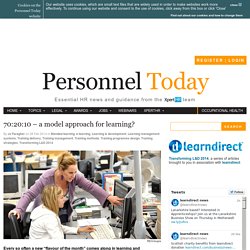
Jo Faragher reports. Popularised by consultant and former chief learning officer Charles Jennings, director of the 70:20:10 Forum, the 70:20:10 concept centres around the idea that the majority (or around 70%) of learning comes through experience, around 20% comes from social learning with colleagues and just 10% through formal learning such as classroom training or online courses. While Jennings himself concedes that this should be “a reference model and not a formula”, the concept continues to generate a lot of debate among L&D professionals, with many claiming to have embraced the model but few actually demonstrating it in practice.
Where to start? This is an approach learndirect adopted when it merged with fellow skills, training and employability provider JHP in 2012. Strategic human resource management. This factsheet was last updated in February 2015.
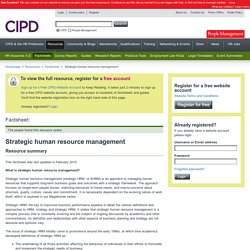
What is strategic human resource management? Strategic human resource management (strategic HRM, or SHRM) is an approach to managing human resources that supports long-term business goals and outcomes with a strategic framework. The approach focuses on longer-term people issues, matching resources to future needs, and macro-concerns about structure, quality, culture, values and commitment. It is necessarily dependent on the evolving nature of work itself, which is explored in our Megatrends series. Strategic HRM: the key to improved business performance explains in detail the various definitions and approaches to HRM, strategy and strategic HRM.
Ef1330en.